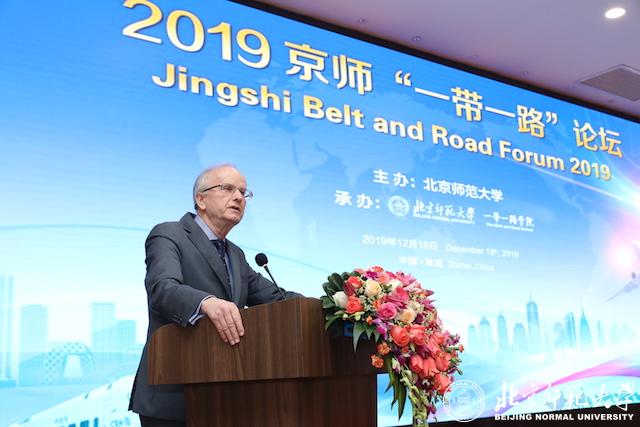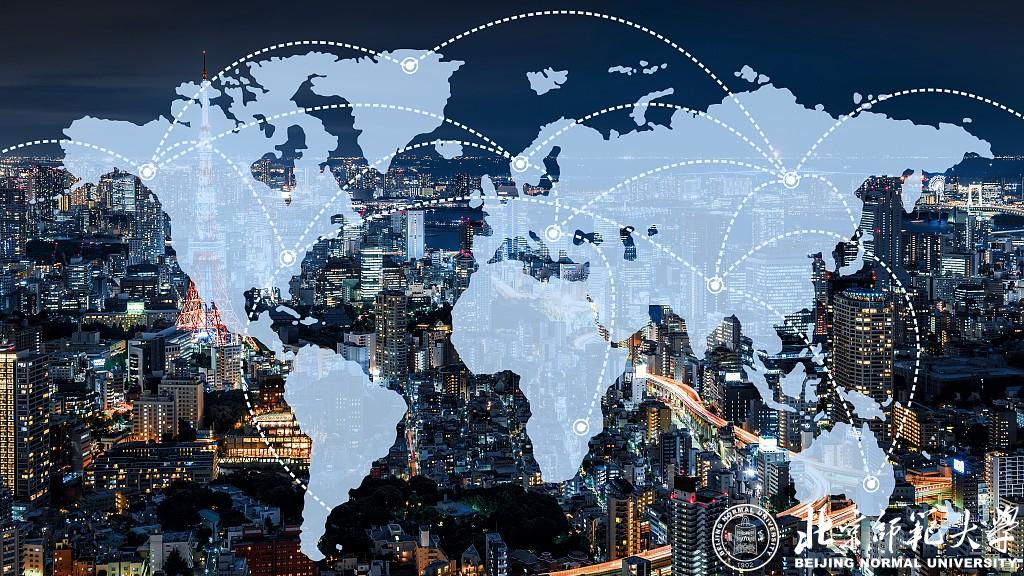
波兰前副总理、北师大一带一路学院特聘教授格泽高滋·W·科勒德克(Grzegorz W. Kolodko) 4月28日在中国日报网发表题为《塑造未来,需要找到更好的路径》的英文文章。他表示,我们需要找到更好的路径来塑造新冠肺炎疫情后的世界新秩序。

图为格泽高滋·W·科勒德克在京师“一带一路”论坛发表演讲的图片资料

以下是经翻译后的中文版内容:
是时候思考这个重大问题了:接下来路怎么走?
在新冠肺炎疫情大流行之后,世界经济和政治体制将向何处去?我们经常听到这样的说法:再也回不到原来的样子了。如果真是这样,那未来会变成什么样子呢?
1929-1933年间的大萧条之后,人们不仅见证了法西斯主义和纳粹主义,还有军国主义以及斯大林主义的兴起发展。美国总统富兰克林. 罗斯福也在1933至1939年推出了经济措施 "新政",来抵御大萧条的影响。
由此可见,经济崩溃带来的不仅有黑暗,也有光明。
二战后,世界被分割成了两个对立的意识形态、政治和经济集团。在他们对峙的阴影下,是发展中国家的广大贫困人口。
不过今时不同往日,发展中国家的人口占全球人口的85%,产出占世界的60%。它们不会再被局限为新兴市场经济体,因为它们已经以“自主经济体”(emancipating economies)在世界舞台上崭露头角。
这一次,他们将有更大的话语权,为疫情后的世界新秩序做出重大贡献。
地缘经济与地缘政治的交织互动不会消失。目前全球领导权并不明确,中美竞争在这样一个动荡的世界中会越来越激烈,导致巨大的危险性。友好的竞争是有益的,而带有敌意的对抗则是破坏性的。
人们应该权衡几个未来路径的利弊。除了回到 "一切照旧 "之外,第二条路径是有限民主下的资本主义。把一些公共事务交给有能力、有效率的技术官僚来解决,这当然有一定的合理性。
然而,在疫情后的世界,有限民主意味着执政精英及其治下的官僚机构主导着公共话语权和决策程序。
在这种情况下,我们必须非常小心,防止限制人员、信息、货物和资本——包括知识资本——流动的暂时性措施成为永久性的。我们需要纪律和民主,但不一定是 "严格受控的民主"。
第三条路径,我称之为"中国主义"(Chinism):一党制下的任人唯贤,实行多元化的所有制,无形的市场之手与有形的国家之手的灵活协同。
这对高度发达的国家并不适用,但对于雄心勃勃的自主经济体来说,这条路径可能会越来越有诱惑力,特别是在非洲、南亚和中东地区。而由于美国传统上对南美和中美洲地区的强大影响力,这条路在该地区的诱惑力可能会小一些。
这个政治模式可能会被证明是有吸引力的,因为中国不仅在过去40年里实现了令人难以置信的经济增长,而且在抗击疫情的斗争中也非常成功。
第四个路径是基于社会市场经济体(social market economies)之间的合作的包容性全球化。在疫情后的世界,尽可能多的国家应该向这一路径发展。当然,这个路径有其特有的文化内涵,也需要市场力量和国家政策之间有恰当的协同,以及需要新型的国际协调合作。
经济体的运行必须在更大程度上以新型的务实主义为基础,重要的是采取温和的措施,注重经济、社会和生态的可持续发展。这样,才可以增进和谐、宽容和同理心,减少剥削、不公和敌对。
未来将是这四条路径的结合体。没有一条路会独占鳌头,也没有一条路会放之四海而皆准。它们的参差共存将会是多变又冲突的。
从现在开始,当我们应对疫情的同时,我们必须奋发努力,永久的抛弃过去的旧体系,为未来塑造更美好的世界。
注:上文由北京师范大学一带一路学院 廖舟 翻译
格泽高滋·W·科勒德克(Grzegorz W. Kolodko)4月28日在中国日报网发表的英文原文如下:
Better paths needed to help shape the future
By Grzegorz W. Kolodko | China Daily Global | Updated: 2020-04-28 09:02
It is time to start asking the big question: What's next?
Which way will the world economy and political systems go after the coronavirus pandemic? We often hear that it will never be the same, but if so, how it will look?
After the Great Depression of 1929-1933, not only fascism and Nazism, but also militarism and Stalinism developed. The New Deal, the economic measures introduced by United States President Franklin D. Roosevelt from 1933 to 1939 to counteract the effects of the Great Depression, also emerged.
This shows that both bad and good things can arise from an economic collapse.
World War II resulted in the division of the world into two opposing ideological, political and economic blocs. In the shadow of their confrontation was the mass of poor people in the developing nations.
Today, the situation is different because developing nations have 85 percent of the global population and account for 60 percent of the world's production. They cannot be pushed further into the emerging markets because they are visible on the world stage as emancipating economies and polities.
This time, they will have much more to say, contributing significantly to the post-pandemic world new order.
Geoeconomics will constantly intertwine with geopolitics. Great dangers will be there, because in the absence of clear global leadership for primacy in such an unstable world, China and the US will increasingly compete. Friendly competition would be fine, while hostile confrontation would be devastating.
Looking to the future, one should consider several alternative options. Apart from a return to "business as usual", the second path would be capitalism of limited democracy. Of course, there is some rationality in transferring certain areas of public affairs to be resolved by competent and efficient technocrats.
Nevertheless, in the post-pandemic world, limited democracy would imply that the ruling elites and their servile bureaucracy dominate main areas of public discourse and the decision-making procedures.
In this case, one must be very careful that the temporary restrictions imposed on the movement of people and information, goods and capital-including intellectual capital-do not become permanent. We need discipline and democracy, but not necessarily "disciplined democracy".
The third path is the spread of what I call "Chinism"-a mono-party but meritocratic system, with ownership pluralism and a flexible synergy of the powers of an invisible hand of market and a visible hand of state.
This is not a proposal for highly developed countries, but it may become an increasingly tempting offer for the ambitious emancipating economies, in particular, in Africa, South Asia and the Middle East, and on a smaller scale in South and Central America due to traditionally strong US influence there.
It may prove to be an attractive political model because China has not only been very successful in managing incredible economic growth in the past four decades, but has also been highly successful in its fight against the pandemic.
The fourth path is inclusive globalization based on cooperation between social market economies, to which as many countries as possible should evolve in the post-pandemic world. Of course, with its own culturally embedded characteristics, it also requires appropriate synergy of market forces and state policy, as well as a new style of international coordination.
The functioning of economies must be based, to a greater extent, on a new pragmatism, taking into account the imperative of moderation, and caring for economically, socially and ecologically sustainable development. Then there will be more harmony, empathy and tolerance, and less exploitation, injustice and hostility.
The future will be a combination of these four paths. None of them will get the upper hand, and none will become universal. Their heterogeneous coexistence will be fluid and conflictual.
It is worthwhile to strive all the time-starting from now, when we have to deal with the pandemic-to shape a better system for the future than those we know from the past. Let them stay there forever.
The author is former deputy premier of Poland,international advisor of the Center for China and Globalization,professor of Kozminski University, Warsaw and advisor and distinguished professor at BRI School at Beijing Normal University. The views do not necessarily reflect those of China Daily.
-
北京校区·海淀校园:北京市海淀区新街口外大街19号
北京师范大学京师学堂2F -
邮编:100875
-
邮箱:brs@bnu.edu.cn
-
珠海地址:广东省珠海市香洲区唐家湾金凤路18号
北京师范大学珠海校区励教楼 -
邮编:519085
-
邮箱:brs@bnu.edu.cn
-
北京校区·昌平校园:北京市昌平区沙河满井路
北京师范大学昌平校园1号教学楼 -
邮编:102299
-
邮箱:brs@bnu.edu.cn

码上关注



